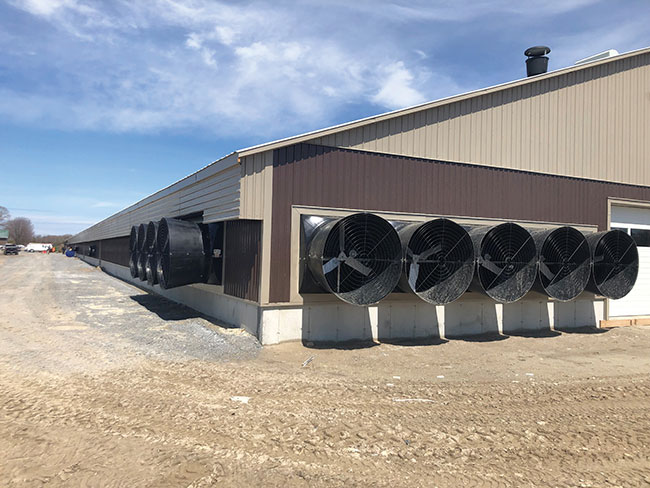
Preparing for colder weather
By Doug Martin
Features Barn ManagementSeven things to check during fall barn maintenance.
 Clean dust and debris from fans, shutter louvers and any supplemental coverings.
PHOTO CREDIT: Cumberland
Clean dust and debris from fans, shutter louvers and any supplemental coverings.
PHOTO CREDIT: Cumberland Cold weather is just around the corner. By spending a few hours now “winterizing” your poultry barns, you can help insure that your birds will stay warm this winter with a minimum amount of fuel usage. The following are recommended maintenance checks from Doug Martin, Canadian sales manager for Cumberland, to help keep birds healthy and productive:
Building integrity
With cold weather right around the corner and predictions of record high fuel prices, now is the time to get your barns ready for cold weather. There are a number of things you can do that do not cost a lot that can help to keep your fuel bills to a minimum, the most important of which is making sure your barns are as tight as possible.
The tighter a barn is, the less expensive it will be to heat. Increasing barn tightness not only minimizes the amount of heat loss when the wind is blowing, but it also helps ensure that when you are ventilating, all the cold fresh air is entering through your inlets and not through cracks in the walls and ceiling.
Air entering through cracks does not tend to mix with the warm air next to the ceiling, which can lead to low temperatures and drafty conditions at floor level. Furthermore, since cold air cannot hold as much moisture as warm air, it is less effective at removing excess moisture from the litter, leading to caked litter and ammonia.
Walk around the poultry barn exterior to check for any holes, damage or other openings that will allow cold air to enter the building. A sealed exterior is important in maintaining proper ventilation flow inside.
Lastly, make sure static pressure controllers read zero when fans are off. If the pressure gauge within your barn does not measure barn static pressure accurately, inlets may open too much causing drafts and excessive fuel usage, or may not open enough, resulting in poor air quality.
Cool cells
Drain cool cell reservoirs and fogger lines inside the building, and drain outside supply lines to prevent freezing. Remove submersible pumps and store them in a warm place. Close off pads outside with some form of closure so they are not affected by the winter elements. This will help to prolong the life of your pads.
Fans
Clean dust and debris from fans, shutter louvers and any supplemental coverings. Check and replace any worn belts and bearings. Spend the time now before it gets extremely cold to look over any winter insert closures that go on unused fans. Have them close by and ready to install quickly at the appropriate time.
Heaters
Blow off dust and dirt that may have accumulated on the top of heaters. They can act like insulation, absorbing heat rather than allowing it to radiate into the building. Inspect heaters to ensure they are in proper working order, especially supplemental heaters that did not run through the summer months.
Clean furnace/brooder burner orifices, which can corrode over time. This can lead to reduced heat output or improper fuel air mixtures. If you have cleaned the orifices a number of times over the years, you may want to consider replacing them because the orifice size tends to increase after numerous cleanings. In addition, check rubber gas lines for cracks or nicks.
Gas pressure
Check the gas pressure. If you feel that you’re not getting enough heat out of your furnaces or brooders, you
may want to have your gas company check the pressure in your gas lines. If the gas pressure is low, the output of your heaters will be reduced. Most heaters require a gas pressure between nine and eleven inches of water column. (You should always check with the manufacturer of your brooder/heater for the optimum gas pressure. This will vary depending on if they are NG or LP).
Air Inlets
Make sure that side wall inlets open uniformly. If the inlets open on one end of the barn more than the other, barn temperature and air quality can vary significantly. Clean screens over side wall inlet openings. Dirty screens over side wall inlets reduce the distances that air can be drawn across the barn by 20 percent or more. This reduces the amount of heating the incoming air receives before it drops to the floor
Controller
A change of seasons is also a good time to check to see if any software updates are available from your controller manufacturer that will provide improved efficiencies for the operation.
These are all fairly easy steps producers can take to ensure an optimal poultry barn environment for the fall and winter seasons. Proper maintenance can help avoid costly repairs and maintain high productivity.
Doug Martin is Canada sales manager for Cumberland. For additional information, visit CumberlandPoultry.com.
Print this page